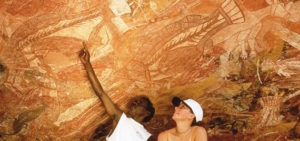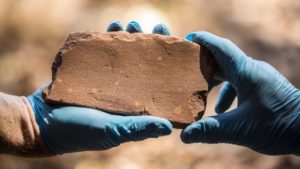Kakadu site of Australia’s earliest home of Aborigines dating back to 65,000 years
 Australian Aborigines have always been thought to be living on this continent for about 40,000 years.
Australian Aborigines have always been thought to be living on this continent for about 40,000 years.
A team of archaeologists and dating specialists have new proof that Aboriginal people have been in Australia for at least 65,000 years ”” much longer than the 47,000 years believed by some archaeologists. The new findings have been published in Nature magazine this week.
The site where this new evidence has been found is Madjedbebe, located on the traditional lands of the Mirarr people surrounded by the World Heritage-listed Kakadu National Park. The site is located on Aboriginal land excluded from Kakadu National Park as a result of the Jabiluka uranium mining lease granted in 1982. The lease is now held by Energy Resources of Australia, which partnered with the Gundjeihmi Corporation to provide access to the site.
Madjedbebe rock shelter has been excavated four times since the 1970s, most recently in 2012 and 2015 by an international team led by Associate Professor Chris Clarkson ”” an Australian Research Council (ARC) Future Fellow at the University of Queensland ”” in partnership with the Mirarr Traditional Owners. A landmark agreement with the Gundjeihmi Aboriginal Corporation (GAC) made it possible for Professor Clarkson and colleagues to dig the site in 2012 and 2015.
Dating carried out by Professor Zenobia Jacobs, an ARC Future Fellow at the University of Wollongong, has revealed that Aboriginal people lived at Madjedbebe at the same time as now extinct species of giant animals were roaming around.
 In addition to showing the deep antiquity of Aboriginal occupation, the dig also revealed new evidence of activities and lifestyle. “The site contains the oldest ground-edge stone axe technology in the world, the oldest known seed grinding tools in Australia and evidence of finely made stone points which may have served as spear tips”, said Professor Chris Clarkson, lead author of the Nature article.
In addition to showing the deep antiquity of Aboriginal occupation, the dig also revealed new evidence of activities and lifestyle. “The site contains the oldest ground-edge stone axe technology in the world, the oldest known seed grinding tools in Australia and evidence of finely made stone points which may have served as spear tips”, said Professor Chris Clarkson, lead author of the Nature article.
“Most striking of all in a region known for its spectacular rock art are the huge quantities of ground ochre and evidence of ochre processing found at the site, from the older layer continuing through to the present,” Professor Clarkson concluded.
“This study confirms the sophistication of the Australian Aboriginal toolkit and underscores the universal importance of the Jabiluka area. These findings reinforce the need for the highest level of conservation and protection for this site,” said Justin O’Brien, CEO Gundjeihmi Aboriginal Corporation.
Short URL: https://indiandownunder.com.au/?p=9245
